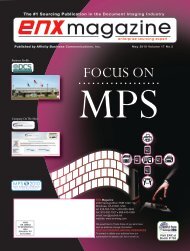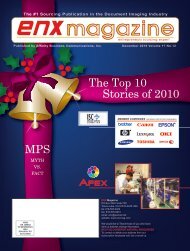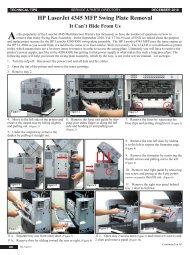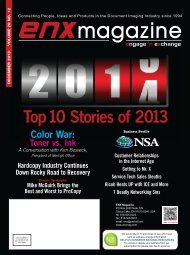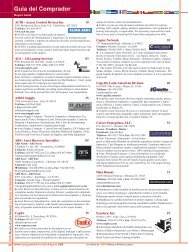You also want an ePaper? Increase the reach of your titles
YUMPU automatically turns print PDFs into web optimized ePapers that Google loves.
FLASH REPORT We Saw It In <strong>ENX</strong> <strong>Magazine</strong> AUGUST <strong>2010</strong>By Ted NeedlemanWHAT YOU SEE IS WHAT YOU GET…SOMETIMES…IF YOU’RE LUCKYEvery vendor in the printer and MFP market touts howgood their color output is. And many dealers turn aroundand parrot that claim.But how many dealers actually show their customers how to getthe best possible color out of their devices? For many dealers,telling the customer that their MFP or printer comes with colormanagement utilities, or Pantone matching tables is the extentof their knowledge. After all, the service technician will calibratethe printer/MFP when it’s installed or serviced.But going that extra mile and making sure that the customer isgetting the best possible output at all times from their devicesmeans teaching the customer a bit about color management andmatching. It takes an hour or two of your time, but can pay offbig time when it comes time for your customer to lease or buya new machine.The biggest step in the process is understanding that great colorrequires more than a tech performing a print calibration, or evenproviding your customer with one or more ICC Profiles. Itrequires understanding what profiles do, and why they are necessary– and then teaching your customer.Color Spaces, Color Gamuts, and The Meaning of LifeBefore you can begin to understand, much less train your customers,why even a well-calibrated printer can produce offcoloroutput, you need a few smidgens of color theory. Ifyou’ve worked in the production print market, you probablyknow most, if not all the following, so feel free to get a cup ofcoffee, and resume reading further on.A color space is all of the colors and hues that a particular technologyis theoretically capable of reproducing. A color gamutfits within a color space, and is all of the colors and hues a particularoutput device (like a printer or monitor) or input device(like a scanner) is capable of producing. In most cases, the colorgamut of a device is considerably smaller than the color spacethat a technology provides. In practical terms, this means thatthere are some colors and hues that a particular output devicesimply can’t reproduce, even though they may exist within thecolor space.If I haven’t already completely lost you, to make things evenmore confusing, different types of devices have different colorspaces. Emissive devices, such as a computer display, generallyhave an RGB color space. That’s because they work by radiatinglight in different frequencies comprised by the three primarycolors -red, green, and blue. That’s true whether the displayis an LCD, LED, or CRT. The combination of these primarycolors produces the color pixel we see on the display.Most printers, on the other hand, render colors reflectively, withcertain frequencies of light bouncing off of the printed surface,and other frequencies absorbed by the printed surface. The neteffect of this is that we see a particular color. While there aresome printers which use red, green, and blue inks, these aremost often used in conjunction with afour-color process that uses cyan, yellow,magenta, and black, or CYMK.The problem with accurate colorreproduction is that the various RGB color spaces (there areseveral), and the CYMK color space, don’t match up precisely.One approach to more accurate color reproduction is the Pantonesystem, now owned by X-Rite. In the Pantone system, a specificcolor is specified as a numerical mix of red, green and blue.A Pantone table in the printer takes this color specification andmatches it with a combination of CYMK toners, which willhopefully reproduce to that Pantone color, or at least very closeto it. So if you know that a bottle of Coke in the image is Coke-Cola red, and it’s specified as that Pantone color RGB mix, whenthe image is printed it should appear in Coke-Cola red.The Fly in the Color OintmentBut having Pantone color tables in a device is not the wholeanswer to accurate color. It assumes that once the service techcalibrates the printer, it’s going to stay calibrated, which it’s not.And it assumes that the calibration procedure, automated ormanual, is actually going to produce accurate colors, which itmay or may not do.Additionally, unless the user’s computer display is also includedin the calibration process, there may be a significant differencebetween what is displayed on the screen and what is printedon the paper. Finally, different output media produces differentresults with the same output file. An image which isaccurate on one type of paper, may not be accurate on another.An Easy SolutionSo how do your customers get accurate and repeatable color ondifferent types of media? Easy – they have to use profiles.Promulgated by the International Color Consortium, commonlyknown as the ICC, ICC Profiles for the monitor and for theprinter/MFP are essentially data tables, similar to Pantone ColorTables, which define the output characteristic of that device.Hardware vendors generally provide ICC Profiles for theirequipment, sometimes even for different popular media types.And if your client uses an application, such as Photoshop,InDesign, or Quark, which are set up to make use of ICCProfiles, they will get more accurate color.It doesn’t stop there, however. To get the most accurate andconsistent color, your customer needs to be able to calibrate theprinter to the display and create their own custom ICC Profilesfor the media types that they are going to use.The key to this process is a handheld device called a spectrocolorimeter.If you are selling an MFP or printer with an EFIFiery controller, the spectrocolorimeter is available as an optionfor about $1,000 or so. The EFI device is a rebadged iOne fromX-Rite, which you can buy from an X-Rite dealer. The iOneworks fine with EFI’s own profile creation software, or withcontinued on 4340enx magazine







